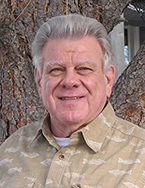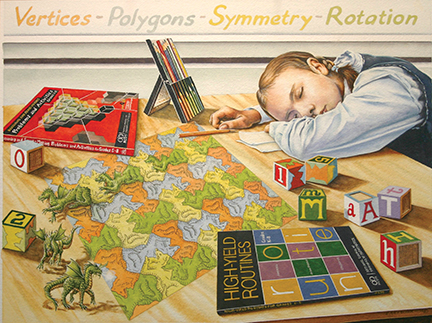 About the Artist...
About the Artist...
As one of the top wildlife artists of the Northwest, Robert Kercher of Great Falls, Montana, has been producing his unusual representations of the world of nature for many years.
Kercher’s versatility in both watercolor and serigraphy (silk-screen printing) is evidenced by the continued acceptance of his work in top state and national shows, including the Easton Waterfowl Festival (Easton, Md.), the National Wildlife Art Show (Kansas City, Mo.), the Pacific Rim Wildlife Art Show (Seattle, Wash.), the Portland Audubon 100th Anniversary Show (Portland, Ore.), and the Classic-American Western Art Show (Beverly Hills, Calif.).
His work has been featured in Wildlife Art, Southwest Art, and Montana Outdoors magazines.
Kercher’s paintings and prints often deviate from realism to graphic storytelling. They often highlight the camouflaging aspects of nature. These transformations or permutations focus on the interplay of flora and fauna in the natural environment.
He's a member of the Montana Watercolor Society and has been selected for inclusion in American Artists of Renown: An Illustrated Survey of Leading Contemporary Artists and American Artists of the Rocky Mountains, Volume I.
Kercher has received numerous Best of Show awards and was selected Artist of the Year by Montana Ducks Unlimited for both 2012 and 2014.
The artist’s works are in more than 1000 private, public, and corporate collections, including the Nabisco Gallery (Hanover, N.J.), the White House collection of former President Ronald Reagan, and the permanent collection of the Smithsonian Institution.
About the Painting...

Math Magic by Robert A. Kercher
National Council of Teachers of Mathematics and Robert A. Kercher © 2014
Math Magic: Artist Statement
Those familiar with my work know that I have produced numerous paintings that featured interlocking shapes, or tessellations. However, my approach to those designs was strictly intuitive. The shapes that I was able to integrate were achieved simply by trial and error. I had never heard of M. C. Escher until I began experimenting with positive and negative shapes. Nor was I aware that tessellations were based on sound mathematical principles. To me, what looked right was right.
The fact that my designs illustrated certain mathematical principles to people who studied math was purely coincidental. Nevertheless, the NCTM representatives urged me to give it a try.
I decided to play with cubes and squares. Knowledge of mathematics and physics may be construed as building blocks from which have sprung some of humankind’s most iconic structures, including the great pyramids of Egypt, the aqueducts of Rome, and the modern skyscraper. So I chose the cube and the square as a design motif that is repeated throughout the painting.
Beginning with the two blocks on the left side of the painting and adding the two blocks next to the young lady’s elbow, we read 2-0-1-5, the year in which this print is to be released. The four other blocks spell out the word math.
Keeping with the same theme, I placed on the desk two math books whose covers repeat the square and block motif. In addition, the very structure of the dragon tessellation is based on the square as its underlying framework.
It is my understanding that by the time most students reach the eighth grade they have been exposed to the study of tessellations and the works of the Dutch artist M. C. Escher. On the whiteboard behind the girl appear the words vertices, polygons, symmetry, and rotation, all words that would be used in a discussion of tessellations.
A question has been raised about why the girl is sleeping in class. To this, I counter, “Who says she is in class?” Perhaps she is working on her assignment at home, or maybe she has stayed after school to complete her work.
The original watercolor painting measures 15 inches by 20 inches and portrays a young student who has been assigned the task of designing her own tessellation by using the knowledge she has gained from her studies. She has worked diligently and has succeeded in creating an image that is hers and hers alone. She has grown weary and has dozed off.
As she sleeps, the dragons come alive and leap off the design and onto the desk. This is the instant when the math magic occurs! Through this young girl’s efforts and application of the rules and principles of mathematics, she has reached a level of accomplishment never before imagined. Metaphorically, anything you dream can come to realization.
Just as some people are amazed that an artist can turn an idea into a visual statement, I am in awe of what our scientists and engineers are able to accomplish with their knowledge of math and physics. Humankind has been able to place a man on the moon, send a satellite into orbit, and link up with a space station hurtling through space. We have been able to land a Rover spacecraft on Mars and even on an asteroid. To me, that is miraculous! That is real math magic.
Robert A. Kercher, Artist